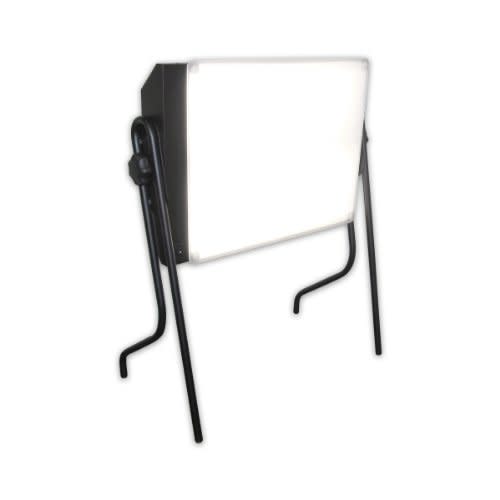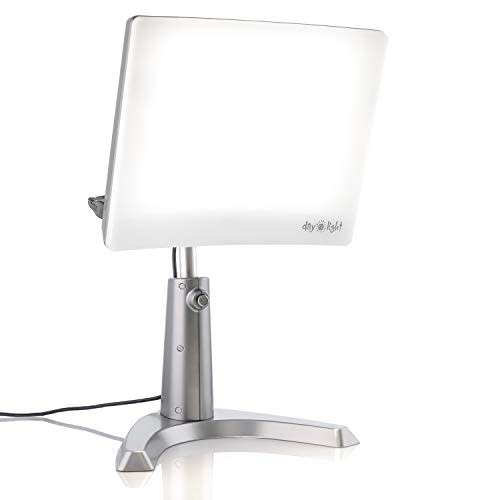What are the benefits of light therapy lamps?
Select independently determines what we cover and recommend. When you buy through our links, we may earn a commission. Learn more.
As the sun rises later and sets earlier during the winter months, odds are you feel some combination of sleepy, less motivated and plain old glum during the day. And to some degree, that’s totally normal, said Dr. Alex Dimitriu, who specializes in psychiatry and sleep medicine, and is the founder of Menlo Park Psychiatry and Sleep Medicine. Our circadian rhythm and other biological clocks are regulated by sunlight, so when there is less of it, we feel drained. Until the sun returns in spring, we can replace missing daylight with light therapy lamps, which simulate the light of a sunny sky and can help boost your mood, among other benefits.
SKIP AHEAD Top light therapy lamps to shop | What is Seasonal Affective Disorder? | Benefits of light therapy lamps | Do light therapy lamps work? | How to use a light therapy lamp
Light therapy is one treatment option for those diagnosed with Seasonal Affective Disorder (SAD), a type of depression that follows a seasonal pattern and is impacted by daylight hours, Dimitriu said. But anyone experiencing run of the mill “winter blues” may benefit from light therapy. To learn more about light therapy lamps — also commonly called SAD lamps, or ironically, happy lamps — and how to shop for them, we consulted experts, who also gave us tips for using them.
How to shop for light therapy lamps
The U.S. Food and Drug Administration does not regulate light therapy lamps, and some options are poorly made, limiting their effectiveness, experts warned us. To ensure you’re purchasing a quality light therapy lamp, look for those with the following features:
Light intensity: Dimitriu and Dr. Michael Terman, president of The Center for Environmental Therapeutics, a nonprofit research and education institution that’s considered an authority on light therapy, and head of the Center for Light Treatment and Biological Rhythms at Columbia Presbyterian Medical Center, recommended purchasing light therapy lamps that offer a 10,000 lux illuminance. Lux is a measurement of light intensity, and 10,000 lux is comparable to ambient daylight. For comparison, typical room lighting ranges from 300 to 500 lux, according to Phillips.
Light screen/panel size: When it comes to the size of the light panel/screen, bigger is better, Terman said — you want to create a full field of light around your face in order to get the full 10,000 lux “dose” of light. The Center for Environmental Therapeutics recommends a surface area that exceeds 200 sq. in. This is made slightly complicated by the fact that most light therapy lamps for at-home use (as opposed to ones you might find in a doctor’s office) are smaller in size and list the length and width of the screen, but not measurements in square inches. To keep it simple, we only recommend lamps with screens that are at least 11-by-8 inches, and discounted any options that were smaller.
UV protection: Overexposure to UV light can damage skin and is what we seek to protect skin from when we apply sunscreen. Because of this, it’s important to make sure you buy light therapy lamps designed with built-in UV-filters or that are labeled “UV-free.”
Adjustability: Your light therapy lamp should not shoot light upwards into your eyes, Terman said, and you should never look directly into the light head-on, just like you should never look directly into the sun. Experts said it’s best to have light come from above you and shine down on you, similar to how sunlight does outdoors. Thus, looking for lamps with adjustable lamp heads and stands is important. If your lamp is not adjustable, try stacking books or other objects and placing it on top, angling towards you as best you can.
Top light therapy lamps to shop in 2023
Per expert guidance, all of the light therapy lamps below have at least a 10,000 lux illuminance, UV protection and have light screens/panels that measure at least 11-by-8 inches. We only included adjustable lamps that you can position so that light shines down on you, similar to how the sun would — experts said this is proper setup (more on other use tips below).
Northern Light Technologies Boxelite-OS
This light therapy lamp is the only one recommended by The Center for Environmental Therapeutics.In fact, Terman worked with Northern Light Technologies to develop this model, which provides 10,000 lux at a distance of up to 14 inches and is UV-free. The light is built with two adjustable legs and an adjustable light panel that measures 15-by-12 inches.
Northern Light Technologies Boxelite-OS

Northern Light Technologies Boxelite-OS $ at Amazon
Northern Light Technologies Boxelite-OS $ at Northern Light Technologies
Carex Day-Light Classic Plus Bright Light Therapy Lamp
Carex says its light therapy lamp offers 10,000 lux at a distance of 12 to 14 inches. The light’s stand is height- and angle-adjustable, and light is projected downward, as experts recommend. Carex says its lamp blocks 99.3% of UV and you can choose between two light settings: One for light therapy and one that’s general room lighting. The light panel measures 16-by-13 inches and the brand says this product is FSA/HSA eligible.
Carex Day-Light Classic Plus Bright Light Therapy Lamp

Carex Day-Light Classic Plus Bright Light Therapy Lamp $ at Amazon
Carex Day-Light Classic Plus Bright Light Therapy Lamp $ at Kohl's
Carex Day-Light Classic Plus Bright Light Therapy Lamp $ at Carex
Theralite Aura Bright Light Therapy Lamp
Theralite’s light therapy lamp offers 10,000 lux at a distance of 12 inches, according to the brand. It projects light downward and you can adjust the angle of the light panel, which measures 11.5-by-8 inches. The brand says the light therapy lamp is UV-free and has four light settings, as well as is FSA/HSA eligible.
Theralite Aura Bright Light Therapy Lamp

Theralite Aura Bright Light Therapy Lamp $ at Amazon
Theralite Aura Bright Light Therapy Lamp $ at Walmart
Theralite Aura Bright Light Therapy Lamp $ at Carex
What is Seasonal Affective Disorder?
Seasonal Affective Disorder (SAD) is a type of depression that follows a seasonal pattern and is affected by daylight hours, explained Dimitriu. Often, SAD symptoms start in the late fall or early winter and subside around the spring and summer, according to the National Institute of Mental Health (though some people experience symptoms in the spring and summer instead, which is less common). Symptoms include sleeping too much, low mood, a lack of motivation and confidence, trouble concentrating, changes in appetite and more, Dimitriu said.
It’s important to remember that there’s a difference between experiencing SAD-like symptoms and actually having SAD — to be diagnosed with SAD, one must meet specific criteria and be evaluated by a mental health professional. If you’re experiencing severe SAD symptoms, be sure to speak to your doctor. And if you’ve been diagnosed with SAD and are considering light therapy as a treatment option, experts told us it’s best to consult your doctor first.
What are the benefits of light therapy lamps?
“The brightness of the sun is the most important factor in regulating our biological clocks through its effects on our circadian rhythm,” Dimitriu said. And during the colder months where there’s less hours of daylight, people enter a “period of winter quintessence,” which involves more sleep, less energy and a dip in motivation. Light therapy lamps' main benefit is their ability to act as artificial sunshine. They work to replace that missing daylight and regulate our biological clocks, helping ensure those clocks are not disrupted, which is when we start to feel those SAD-like symptoms.
Do light therapy lamps work? Are they effective?
For decades, extensive research has been conducted about light therapy as a treatment for SAD and the “winter blues.” And if you use the right lamp correctly, it can improve SAD or SAD-like symptoms. But experts emphasized that consistency is everything when it comes to seeing a response from using light therapy lamps. Dimitriu said you’ll usually notice a response from about two weeks of consistent use, but everyone’s body is different.
How to use a light therapy lamp
Using a light therapy lamp correctly is just as important as purchasing the right one, experts told us. Below are tips to help you get started.
How long should you use a light therapy lamp for?
Experts advise using light therapy lamps for about 30 minutes at a time. Since you should not look directly into the light, you can use it while working, eating meals, watching TV and more.
How to position a light therapy lamp
In addition to ensuring that light shines down on you, Dimitriu recommends setting up your light therapy lamp about a foot away from you. Many brands specify exactly how far away from you to place the lamp in the directions they include with the product, which you should pay attention to. If you’re further away from the light than is recommended, the light intensity will drop, which might mean you need to use the light for longer than 30 minutes to fully benefit from it.
What time of day should you use a light therapy lamp?
Generally, experts advise using a light therapy lamp first thing in the morning. But if you want to get a bit more specific, Terman recommends identifying your chronotype, or the natural inclination of your body to sleep at a certain time — it’s what people are referring to when they say they’re an “early bird” or a “night owl.” Terman said research has shown that chronotype plays a role in determining when light therapy would be most effective for each individual. To determine your chronotype and how that correlates with the best time to use a light therapy lamp, The Center for Environmental Therapeutics created a free, online questionnaire anyone can use.
Regardless of your chronotype, you should avoid using light therapy lamps at night, as they can cause insomnia and disrupt sleep for some, Dimitriu said.
How often should you use light therapy lamps?
People with mild “winter blues” symptoms may choose to use light therapy lamps occasionally. But consistent daily use yields the best results. Overall, “the body loves rhythm, and in the darker months, you really need to be consistent in replacing sunshine with the same reliability as the sun,” Dimitriu said.
Additionally, using a light therapy lamp is no substitute for the great outdoors. Even on a gloomy day, Terman said the level of light available outdoors is better than it is indoors, so stepping outside for a few minutes or taking a walk is beneficial.
Meet our experts
At Select, we work with experts who have specialized knowledge and authority based on relevant training and/or experience. We also take steps to ensure that all expert advice and recommendations are made independently and with no undisclosed financial conflicts of interest.
Dr. Alex Dimitriu is the founder of Menlo Park Psychiatry and Sleep Medicine and BrainfoodMD. He is double board-certified in psychiatry and sleep medicine.
Dr. Michael Terman is a professor of clinical psychology in psychiatry at Columbia University’s College of Physicians and Surgeons. He heads the Center for Light Treatment and Biological Rhythms at Columbia Presbyterian Medical Center and the Clinical Chronobiology Program at New York State Psychiatric Institute. He is also the president of The Center for Environmental Therapeutics.
Catch up on Select’s in-depth coverage of personal finance, tech and tools, wellness and more, and follow us on Facebook, Instagram and Twitter to stay up to date.
